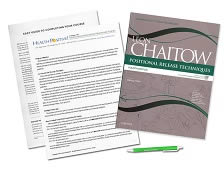24 Hour CE Course

Do you have the Positional Release Techniques textbook? See your enrollment options above for "I already own the text".
This advanced course explores the core concepts of positional release techniques for muscle and joint problems. The textbook, by Leon Chaitow, ND, DO, communicates the ideas, theories and history of many different approaches and includes online videos that shows how the author applies his techniques. This course does not teach hands-on skills. Please seek additional experience, with a mentor, to add hands-on skills.
VERY INTERESTING COURSE.I WILL USE IT IN MY PRACTICE AND ALSO AS A REFERRAL GUIDE.Bernard Howell
The book is detailed and an excellent reference - the illustrations and positioning notes are useful, exacting and understandable. Although the material is an advanced read, it makes sense!Bob Garza, M.Ed., RMT
Thanks this was great!Brian Sari, CMT
I found this course to be very informative and useful in my career. I work alongside of a chiropractor, and a lot of the positional release techniques are very useful in my practice.Claire Balint, LMT, NCTMB
I loved this course! I had a very difficult personal time and the staff were wonderful in extending my class time for submission which I greatly appreciated. Thank you so much!!Denise A. Volmer, LMT
This course provides information that allows a massage therapist tools which a physical therapist would typically use. Great knowledge when working in the medical practice.Jakki Wienecke, CMT, BFA - Bel Air, MD
This course was terrific. It is very in-depth and has lots of good info. It's written in a good way, but a new therapist might get lost in the terminology.Laura Hess, NCTMB
Great Book! Easy to find anwers when I didn't know them from the reading. You did an excellent job, very easy to understand and complete.Laura Seal LMT,AMTA, Healing Body & Soul, LLC. Lake Geneva, WI
Loved this course. Packed full of information!Lisa Stabe, LMT, NCTMB
A wealth of info here! After 20+ years in massage, this course has provided me with several more areas of study to help build my expertise. Will be a future reference tool in my practice. Thank you!Lowell Seeman, NCTMB, LMT
I really enjoyed the practical information. I love trigger point therapy and with prt training it has enhanced my knowledge and my practice. Thank you!Shirley Milner, LMT
Very informative and technical course. I will definitely use in my practice and use book as a constant reference. I have never been disappointed with any course I have taken from Integrative Healthcare Studies. I have referred many colleagues.Yalanda Patria, LMT
Extremely comprehensive material. Definitely worth the time and a great tool for a practitioner.Zachary Bell, LMT, NCTMB
The course material was far more substantial than expected. The text books makes an excellent reference book for the office library.Tonia Zanter, LMT
Excellent course study, very well put together and presented to the advanced therapists. I look forward to my next pick for obtaining CE's online.Heriberto Soltero, LMT, BCTMB
This course was very interesting. It had my attention. My schedule is full so I had to make time to study but it was easy to pick my right back up and continue the course. I am looking forward to my next course.Jenny Raety, LMT
There was a lot of information to take in with this course. It was all very helpful and great information though. I would recommend this course for sure. It is a lot of work but totally worth it!Heather VanHoesen, LMT
Really a great presentation of this information. This course is quite difficult and the knowledge acquired should be very useful in my practiceJohn LeMunyon, LMT
"A crowding of the tissues to induce slackness in the affected tissues is a usual final aspect of the 'fine-tuning' once initial point reduction has been achieved. Additional ease can often be achieved by asking the patient to fully inhale or exhale to evaluate which phase of the breathing cycle reduces point (or which reduces increased tone the most).
Eye movements can also be used in this way - always allowing the patient's report of pain levels and/or your palpation of a sense of ease in the tissues, to guide you towards the 'comfort zone'.
Tips and comments about positioning into ease
(Positional Release Techniques by Leon Chaitow, 2nd ed., 2002, p. 50)
Which of the following applies to fine-tuning the ease position?


Take our free online course: Ethics Refresher
We will not rent/sell your email to anyone.
You'll also receive our newsletter and special offers.
Thank you! An email will be sent to the address provided with instructions on how to enroll in this 1 CE hour course - FREE!
If you do not see our email within a few minutes of signing up, please check your Spam/Junk folders it may have been delivered there instead of your inbox.
If, by chance, you still have not received it within 5 minutes, please call us at 1-800-364-5722, Monday-Friday, 9am-5pm EST for assistance.